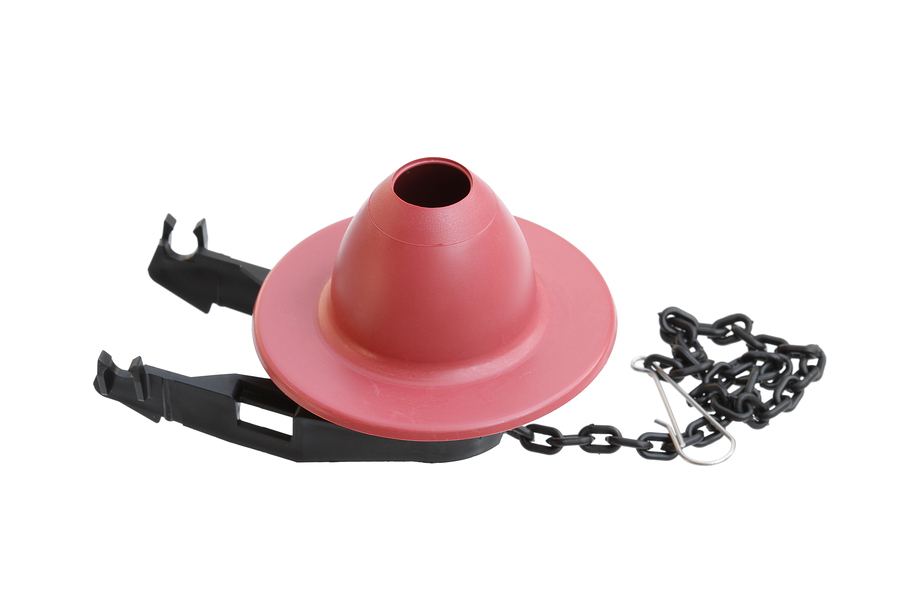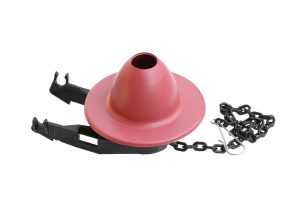The first images that come to mind when you think “flapper” is a 1920’s woman dressed in fringe, smoking a cigarette and doing the “Charleston”. But when you’re talking about issues in the toilet and your plumbing, the flapper valve is the most common issue.
What is a Flapper Valve?
The flapper valve is a rubber plug that fits over an opening at the bottom of your toilet’s tank. It is attached to flapper guides—two arms that hold either side of the rubber flapper. A chain (or rod) is attached to the top of the flapper, which is then hooked to a bar at the top of the tank. This bar is what is attached to your flush handle. When you press the handle to flush your toilet, the flapper valve lifts up, thanks to a pulley system. Once lifted, it allows all of the water from the tank to fill the toilet bowl.
The flapper will float after it’s been released, but as the water drains out of the tank, it will settle back into its hole, sealing it shut so water can start to refill the tank. (The water will fill to the top of the overflow tube, which cues it to stop filling.)
The flapper valve is meant to have a tight seal, allowing the tank to refill with fresh water without leaking. When the valve becomes dirty or simply starts to wear out, problems will arise.
Flapper Faults
Some issues with your flapper valve can be simple to fix—sometimes the chain breaks or comes undone, so you’ll have to replace the chain (or wire) on the lift bar. You want the chain to be taunt and straight, but not so short that it’s already lifting the flapper before the handle is flushed. A chain that’s too long could flop into the hole with the flapper, thus preventing it from sealing.
Some homeowners might resort to jiggling the toilet handle just right to get the flapper to seal the water when the leaks start, but this trick will eventually stop working. You’ll want to make sure that the edge of the hole, and just inside of it, is free from any gunk that might mess with the flapper seal. To do this, turn the water to the toilet off, then flush the toilet to empty the tank. Clean the hole with a cloth, first, then scour with a scouring pad. Turn the water back on and flush the toilet to see if that solved the problem.
Flapper valves are inexpensive to purchase ($5 or less), but can vary depending on the make and model of your toilet, so do your research before you head to the hardware store.
If that doesn’t solve the problem, then it might be that the flapper has started to wear over time, thus losing that water-tight seal. If you start to hear a trickling noise in your toilet, followed by an occasional surge of supply water topping the tank, a faulty flapper valve is to blame. While this is an annoying issue, it can also cause your water bill to go up with the overuse of water.
Replacing the Flapper Valve
First, turn off the water supply to your toilet by closing the supply line to the tank. Drain the water from the tank into a bucket, then disconnect the water supply line. You should be able to easily remove the old flapper valve—some snap on while others might just use a small hand screw. Note the toilet make and model and take a look at your old flapper valve before heading to purchase supplies. Experts suggest even taking the old flapper valve with you, once you’ve removed it from your toilet, of course.
Be wary of generic flapper valves and try to purchase the exact brand valve to coincide with your toilet.
Once home, it’s time to install your new flapper valve. Use an emery cloth to smooth any rough edges around the lip of the valve seat. The rough edges could prevent the watertight seal between the flapper and the seat that you want. Then follow directions to install your flapper valve.
If you have any plumbing questions, contact the experts at Lindstrom Plumbing and take advantage of their more than 40 years of experience.



